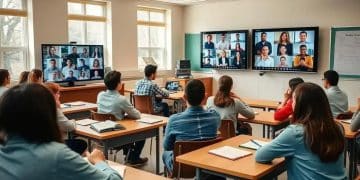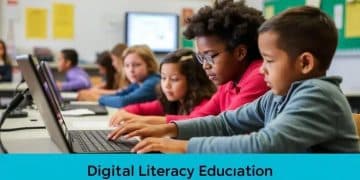Multilingual education strategies in urban schools

Multilingual education strategies in urban schools enhance student engagement and performance by integrating diverse languages, promoting cultural awareness, and actively involving families and communities in the learning process.
Multilingual education strategies in urban schools play a crucial role in fostering inclusive environments. Have you ever thought about how these approaches can benefit diverse student populations? Let’s dive deeper into these strategies and their impact.
Understanding multilingual education
Understanding multilingual education is essential for creating effective learning environments in diverse urban schools. It involves teaching students in multiple languages, which can significantly enhance their learning experiences and help them succeed academically.
Key Concepts of Multilingual Education
Multilingual education is not just about language proficiency; it encompasses cultural awareness and inclusion. By integrating different languages into the classroom, students are exposed to various perspectives that enrich their understanding of the world.
- Enhances critical thinking skills
- Promotes cultural exchange
- Prepares students for a globalized world
Moreover, multilingual education fosters a sense of belonging among students from different backgrounds. They feel represented and valued, which boosts their confidence and participation in class. This inclusive approach encourages collaboration among peers and builds strong community ties.
Benefits of Multilingual Education Approaches
There are several benefits to implementing multilingual education strategies in urban schools. Students who learn in their native languages are often more engaged and perform better academically. Additionally, it allows for seamless transitions between languages, making learning more fluid.
- Improves literacy skills
- Facilitates better communication
- Enhances cognitive flexibility
Integrating multiple languages into curriculum also prepares students for future careers in a global workforce. They become more adaptable, learn to communicate effectively, and develop skills that are increasingly valuable in today’s job market.
Effective strategies for urban classrooms

Effective strategies for urban classrooms are vital for fostering an inclusive and engaging learning environment. In these diverse settings, teachers can implement various techniques to support multilingual education that meets the needs of all students.
Utilizing Culturally Relevant Pedagogy
Culturally relevant teaching involves connecting the curriculum to the students’ backgrounds. This approach creates a more relatable and engaging learning experience. When students see their cultures reflected in the lessons, they feel a sense of belonging.
- Incorporate local history and traditions into lessons.
- Use diverse examples that resonate with students’ lives.
- Encourage students to share their cultural experiences.
Moreover, integrating multilingual resources can enhance understanding. Teachers can include books, articles, and videos in various languages, enabling students to access information in their preferred languages.
Collaborative Learning Opportunities
Collaboration fosters peer-to-peer learning and communication. Group activities can break down language barriers and enhance social skills. In an urban classroom, assigning students to diverse groups encourages them to work together and learn from one another.
- Create mixed-ability groups for projects.
- Use group discussions to promote language skills.
- Implement peer tutoring to enhance understanding.
Furthermore, by utilizing technology, teachers can bridge gaps in language understanding. Digital platforms offer interactive language learning tools that can engage students and personalize their learning experiences.
Challenges in implementing multilingual approaches
Challenges in implementing multilingual approaches in urban classrooms can significantly affect the effectiveness of education. These challenges can arise from various factors that influence how languages are taught and learned.
Resource Limitations
Many schools may struggle with limited resources, including access to multilingual materials such as books and teaching aids. This can impede teachers’ ability to provide diverse linguistic resources. Without adequate funding, it can be hard to support programs that promote multiple languages effectively.
- Insufficient bilingual textbooks and teaching aids.
- Lack of training programs for multilingual teaching.
- High turnover rates among staff familiar with multilingual education.
Moreover, schools often face budget constraints that limit their ability to hire additional teachers who are proficient in multiple languages. This shortage can affect student learning outcomes and diminish the overall effectiveness of multilingual education strategies.
Teacher Preparedness
Teacher preparedness is another critical factor. Educators may not have received adequate training in how to effectively implement multilingual instruction. This lack of training can lead to uncertainty in lesson planning and classroom management.
- Need for professional development in language teaching.
- Difficulty in maintaining students’ interest across languages.
- Increased workload for teachers managing diverse needs.
Additionally, teachers may feel overwhelmed by the need to balance multiple languages and cultures in their lesson plans. This stress can lead to burnout, further impacting the quality of education students receive.
Engaging families in language learning

Engaging families in language learning is crucial for reinforcing multilingual education at home. When families participate, students tend to perform better in school. Getting families involved creates a supportive community around language learning.
Strategies for Family Engagement
One way to encourage family involvement is by organizing workshops that educate parents on the benefits of multilingual education. These workshops can demonstrate effective practices for supporting their children’s language development.
- Host language nights where families can learn together.
- Provide resources such as bilingual books and apps.
- Encourage parents to share stories in their native languages.
Additionally, schools can send home materials in multiple languages to ensure parents understand the curriculum and their role in their child’s education. This practice fosters an inclusive atmosphere and empowers families to support their children.
Creating Community Programs
Schools can establish community programs that bring families together to celebrate linguistic diversity. Events like cultural fairs or language festivals not only promote language learning but also strengthen community bonds.
- Organize cultural exchange events with food and music.
- Facilitate family discussion groups in different languages.
- Involve community leaders to highlight local languages.
This shared engagement helps create an environment where languages are valued. By encouraging parents to take an active role and collaborate with schools, students are more likely to feel confident in using their language skills.
In conclusion, fostering multilingual education in urban schools encompasses various strategies and community efforts. Engaging families, providing necessary resources, and addressing challenges can significantly enhance students’ learning experiences. By creating an inclusive environment, we prepare students not only for academic success but also for their future in a diverse world. Embracing languages fosters unity and understanding among communities, paving the way for a brighter future for all.
FAQ – Frequently Asked Questions about Multilingual Education in Urban Schools
What are the main benefits of multilingual education?
Multilingual education enhances cognitive skills, promotes cultural awareness, and prepares students for a diverse and globalized world.
How can families get involved in their children’s language learning?
Families can participate by attending workshops, using bilingual resources at home, and engaging in community language events.
What resources are necessary for effective multilingual education?
Schools need access to bilingual books, teaching materials, and trained educators to properly implement multilingual strategies.
What challenges do schools face when implementing multilingual education?
Challenges include limited resources, insufficient teacher training, and the need for strong family and community engagement.





